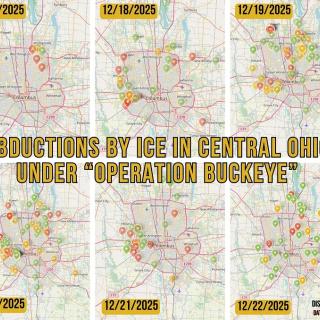Advertisement
Since the beginning of the recent protest movement around the deaths of multiple unarmed African American men at the hands of police in multiple states there has been a push for police to wear body cameras. In the Tamir Rice and John Crawford III cases here in Ohio, video exists in the public sphere that clearly shows what happened. Yet in both cases the policeman who pulled the trigger is still free to roam the streets and still feeding at the public trough.
This push has come from within some sectors of the civil rights movement, from private police groups involved in repressing demonstrations, and from the White House itself. A closer look at body cameras, their packaging and companion products, and manufacturers yields a vista of constant public surveillance.
Use of the term “body camera” gives us an image of a small digital camera on a police officer's chest that acts in the fashion of a camcorder, with a record/play buttons and a limited amount of storage. This is a false image. Two of the three leading manufacturers of police body cameras, L-3 Mobile Vision and Motorola, manufacture cameras that are default connected to cellular devices. The third market leader, Taser International, has an option to automatically connect their body camera product to an Android or I-Phone.
A police body camera can constantly record and transmit what is recorded via law enforcement only cellular channels to a central station that can store it. These central stations can also send video back to the officer, and back up their stored data to the cloud. Taser International's body camera offering, AXON, directly uploads GPS tagged data to their own cloud computing service called evidence.com.
This cellular potential also turns the officer into a WiFi hotspot. Motorola's product line includes a police car that is its own WiFi hotspot and also has eight cameras built into the vehicle facing in every direction, constantly recording. The amount of data that can be hoovered up during a single patrol shift is amazing. The processing that happens to that data afterwords is frightening.
Imagine walking down the street and being passed by a police car. You look at it. Your face has been recorded either by the camera on the car or the camera on the officer. That image of your face is uploaded to a central database complete with metadata tracking your exact location and the exact time. Your face can then be scanned in the memory banks by facial recognition software. If for instance you are sitting in cafe talking with a friend as the car drives by, you are both recorded together. Such scenarios would seem to be the stuff of dystopian fiction, but the mechanisms are already in place.
The FBI began a pilot program to incorporate facial recognition software into its Next Generation Identification (NGI) system. Within in this system, there is a special list called the Repository of Individuals of special concern (RISC). RISC, as described by the FBI, “enables officers and agents in the field to screen detainees and criminal suspects against a repository of Wanted Persons, Sex Offenders Registry Subjects, Known or appropriately Suspected Terrorists, and other persons of special interest for rapid identification.” Thus so-called “appropriately suspected terrorists” and “other persons of special interest” can now be picked out of a crowd. When that crowd is in the cloud the special interest can happen long afterwards. A person with no criminal history or intent can simply walk down the street or have a cup of coffee in public and be of interest later.
Perhaps you sit in the back of the cafe or face away from the window. Your car gives you away. The constant data streaming from police cameras also vacuums up license plates. The camera on an officer and the cameras on the car constantly view, transmit and record this data, complete with location and time metadata. Both Motorola and L-3 Mobile Vision integrate license plate reading technology into their solution packages for law enforcement.
In Ohio, L-3 Mobile Vision's existing statewide purchasing contract makes them the most likely choice for an integrated solution. L-3 Mobile Vision's parent company, Titan L-3, was one of the government contractors involved in the Abu-Ghraib torture scandal in Iraq. One of the L-3 employees, who was working as a translator, raped at least one male juvenile prisoner. He was not fired.
Once the data has been acquired, it can be processed by MorphoTrak, one of the key contractors for the FBI's NGI system. Before being acquired by a subsidiary of SaFran, MorphoTrack was called L-1 identity solutions. It was founded by Robert LaPenta, who also founded Titan L-3. Before founding Titan L-3, LaPenta was an executive at Lockheed Martin, which provides overall integration for the NGI system. A seamless flow of personal data will exist from the police officer's body camera to an FBI database. That seamless flow will further fatten the wallet of a man who directly profited from the rape of child prisoners. It appears that human rights are not central design parameters of this new system.
The sum total of the proposed body camera solution to the problem of police violence is a regime of constant surveillance. This new scheme records everyone for later identification the instant a police officer's device sees them or their car. It creates the basis for a national database that tracks every movement of every single person in the country.



